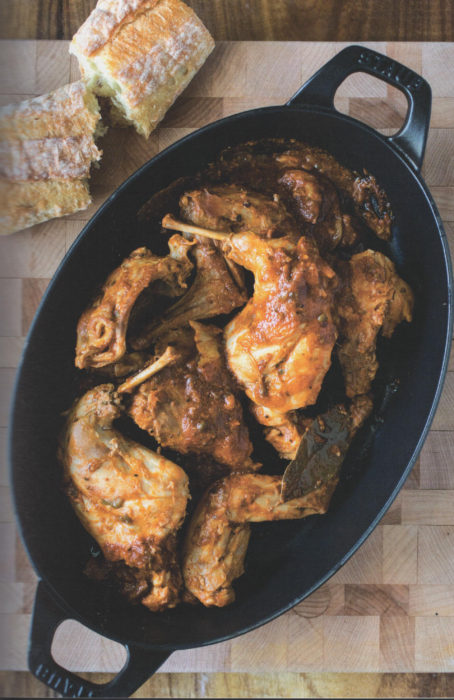
Yes, it’s rabbit. And people will tell you rabbit tastes just like chicken. In fact, author Anna Francese Gass of Heirloom Kitchen even says you can substitute chicken here if you are rabbit shy. [Today’s review of Heirloom Kitchen is right here.]
Don’t substitute. Get over that fear of eating Peter Rabbit. Peter is just a story. Rabbit is serious food. Italians love rabbit for good reason: it does not taste just like chicken. There is a distinctive flavor and texture that is definitely non-chicken [free range aside!]. There is a heartiness to rabbit that chicken just cannot supply.
This recipe is very authentic, from the home kitchen of one of the immigrant women featured by Anna in her book. This is just the recipe you’ll find in the fall kitchens of Sardinia and mainland Italy. Suzi and I were in Tuscany one fall on a hilltop. The trees were in brilliant colors. The air was filled with the sounds of gunfire. And later in the day, men would come up the pathways, gun over one shoulder and a few rabbits held in their other hand.
I avoided walks in the woods that day. And the next. More gunfire.
Pair this dish with some roasted carrots or beets. Or both. And offer up a rich red wine to match the glory of rabbit. You’ll love the double sour hit of capers plus white wine vinegar.
Sardinian Rabbit
Yield: serves 4
Ingredients:
- One 2-pound rabbit, washed and trimmed of all excess fat
- ¼ cup plus 2 tablespoons extra-virgin olive oil
- 4 garlic cloves
- 4 bay leaves
- 2 teaspoons coarse salt
- 1 teaspoon freshly ground black pepper
- ½ cup (120 ml) dry white wine
- ¼ cup (60 ml) white wine vinegar
- 2 tablespoons capers, drained and rinsed
- 3 tablespoons tomato paste
Preparation:
Thoroughly wash the rabbit and dry with paper towels. Cut it into six pieces, through the joints. Set aside.
Heat the olive oil with 3 garlic cloves in a large sauté pan over medium heat for 3 minutes.
Add the rabbit pieces and bay leaves, and brow. the meat for 5 minutes. Remove the garlic.
Flip the rabbit pieces and cook for 5 more minutes. Add the salt and pepper.
Add the wine, vinegar, and capers and simmer for 3 minutes. The meat should release from the pi.
Add the tomato paste and the remaining clove garlic. With a wooden spoon, carefully mix the pas into the pan sauce, turning the meat to cover with the liquid.
Pour ½ cup (120 ml) water into the pan, reduce the heat to low, and cover. Simmer for 10 to 12 minutes.
Remove the lid and check the dish: It is done when the oil begins to separate and the sauce is a deep red color.
Source: Heirloom Kitchen by Anna Francese Gass [Harper Design, 2019]
